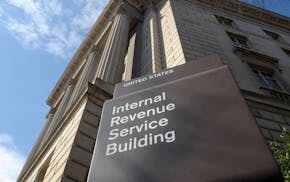With a revised budget proposal, Gov. Mark Dayton threw in the towel for this year on tax reform. The DFL governor is nearly back where he started when he was elected in 2010, promoting higher income taxes for the state's top earners as the best way to end a long run of state deficits and provide a needed boost in education spending.
Gone from Dayton's new plan for the state's 2014-15 budget is any element of his previous plan to broaden the sales tax base to clothing and an assortment of services while simultaneously reducing the sales tax rate. Also absent is his plan to send every homeowner in the state a $500 property tax rebate, which would have cost the state treasury $1.4 billion in the next two years.
What remains is a new top income tax bracket (see box, right), plus the closure of some corporate tax loopholes and a 94-cent-a-pack boost in the cigarette tax. By the administration's tally, the state's top marginal income tax rate would affect 54,000 filers, including 6 percent of the businesses whose profits are treated as personal income for tax purposes.
That may not be many. But the top rate Dayton proposes, 9.85 percent, would be the fourth-highest in the nation. That's a competitively uncomfortable perch for a state that's home to 19 Fortune 500 companies that aim to attract top talent.
With his original budget proposal, Dayton erred by trying to take tax reform too far. He sought to put the sales tax on business-services purchases — legal, accounting, advertising and the like — in a way that would harm those service industries and build hidden taxes into the price of consumer goods. That proposal met with stiff opposition from this newspaper and many others.
But Dayton's other early ideas for a broader consumer sales tax base had merit. Services are a growing share of consumer purchases. Taxing more of them would bring more stability to state revenues. Adding the sales tax to clothing purchases — as all but four other states with sales taxes do — seems like unfinished 20th-century tax policy business.
Legislators should take note: Dayton has dropped those ideas, but he did not say he would block them with a veto if they returned to his desk in bill form. Reviving even a few of them would allow for a reduction of the income tax rate Dayton proposes into more competitive territory. This page recommended on Feb. 17 a top marginal rate no higher than 9.4 percent; a favorable state budget forecast since then should make a rate closer to 9 percent possible while still paying for Dayton's proposed spending increases for education. The state also should raise taxes on alcohol for the first time since 1987.
Dayton said he intends to sell his plans to Minnesotans in coming weeks. He'll need to. There already are plenty of voices — and not just those of Republican elected officials — arguing that a forecasted $627 million deficit in 2014-15 can be erased with spending reductions, and that no tax increase is warranted.
In that argument, the governor ought to have the upper hand. This is the 11th year of the last 12 in which the Legislature has confronted a deficit as it balanced the budget. It has coped by squeezing investment in things vital to the state's economic future, particularly early education and higher education, and by allowing regressive local property taxes to climb.
It's time for the coping to end. The economy is improving. If Minnesota does not step up investment this year in its best economic asset — its human capital — its willingness to ever do so has to be questioned.
Dayton says he's open to variations on his tax plan. We hope a modicum of tax reform still has a chance. The governor said he will insist only on a budget that does not use one-time money or accounting tricks, and that renews investment in the public goods on which the economy relies. That's a strong bottom line on which he should keep standing as negotiations with the Legislature commence.
Readers Write: Politicized education, presidential debates, election strategies, small-town papers

Taxes increasingly paying for the past — not the future
!["Since the [Hennepin Healthcare System] Board took control in 2007, CEO pay increased by more than 142%. Meanwhile, that same board sunsetted employee](https://arc.stimg.co/startribunemedia/J7MD7DSJWMP3KYIYUSCQTABOAA.jpg?h=91&w=145&fit=crop&bg=999&crop=faces)

